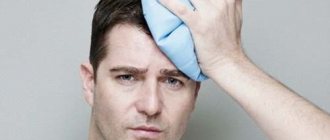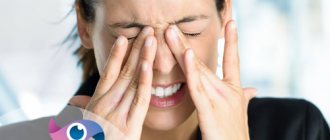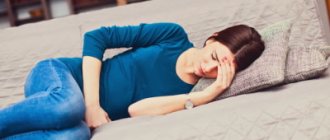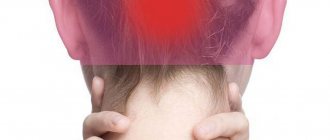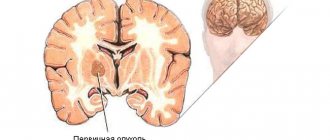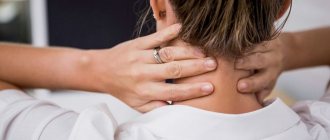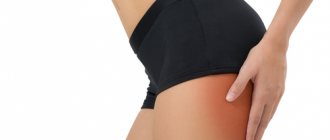Headache when moving your eyes is an unpleasant sensation that many have experienced. It often causes fatigue and does not lead to serious consequences if you give your eyes rest. In some cases, pain in the head when turning the eyes is caused by dangerous pathologies. Let's find out which ones exactly.
If headaches that occur when moving the eyeballs go away after the eyes rest, then there is no serious cause for concern. You need to properly organize your workflow, do eye exercises and, if necessary, use special drops. These measures will not help with pathological processes. You need to see a doctor.
Why do my head and hands shake?
3 Cervical osteochondrosis or neuritis
A simple but effective way to get rid of headaches! The result will not be long in coming! Our readers have confirmed that they use this method successfully. After carefully studying it, we decided to share it with you.
February 12,
A person is capable of productive activity if he feels good and nothing bothers him. Well, if something constantly starts to hurt, you don’t want to do anything. The most common problem is a headache. The back of the head is throbbing with pain and seems to be shooting.
The relationship between headaches and vertebral pathologies
Often the pain moves to the neck. There are a number of reasons that cause such feelings, and it is very important to establish the true one in order to be able to get rid of the problem. Self-medication can only cause harm, so the best solution would be to go to the hospital.
Causes of trembling head and hands
Clinicians identify possible causes of trembling of the head and hands:
- drug use and alcohol abuse, other types of pathological addiction;
- tremor of a hereditary nature (the so-called essential tremor, usually appears after 25 years);
- diseases and damage to the cerebellum;
- a consequence of taking certain medications;
- consequences of stress, prolonged or sudden fear;
- physiological tremors after severe fatigue, overexertion.
As you can see, there are quite a few reasons for trembling. Tremors can be caused by any psycho-emotional stress, for example, a student session or public speaking. Often, emotional tremors disappear on their own and do not require treatment. However, a consultation with a neuropsychiatrist will not hurt.
As for addictions, tremors can appear after consuming large doses of coffee, alcoholic beverages, drugs and medications.
I'll start with the main thing - HEADACHES CANNOT BE TOLERATED. See a doctor immediately.
Next, several times a day, when the condition or nature of the pain changes, write down the date, data and type of pain. This will help you understand and control yourself, and correctly describe the symptoms to the doctor.
Further. The reasons may be very simple, but very common.
1. You sit a lot in the wrong position, which causes the neck muscles to be overstrained and the blood supply to the brain to be disrupted.
2. Physical inactivity.
Start moving immediately, walk outside, ventilate the room more often, and CHARGE, effortlessly, but regularly. 3.
A lot of strain on the eyes and, as a result, overload of the brain. Yes, this is primitive, but it is what most often causes pain.
the system chose this answer as the best
add to favorites link thank
Analostank [25.9K]
Oh, mommies, part of the sentence fell out!! Several times a day you need to measure your blood pressure, and then write down the data and the condition in which it was measured! Sorry - 4 years ago
The best thing to do is consult a neurologist. It is possible to do an MRI (magnetic resonance imaging of the head), it shows cerebral circulation disorders. Perhaps some nerve is pinched, so in a certain position the head hurts, but in another it does not hurt.
I myself am sometimes very worried about headaches, sometimes there is a throbbing pain in a certain part. And my mother suffered from acute cerebrovascular accident, suffered several strokes, and died from this. But the neurologist said that the headache due to poor circulation is constant and severe.
Therefore, the direct route to the doctor is better to be safe than sorry!
In most cases, the systematic appearance of occipital pain or its constant presence signals disorders occurring in the vascular, nervous or spinal system, as well as the formation of tumors or hematomas in this area.
Also, a headache in the back of the head can be provoked by non-pathological factors: weather dependence, air travel, uncomfortable sleeping position, nervous overstrain.
Severe headache in the back of the head
Severe occipital pain is evidence of acute inflammatory processes occurring in this area. It can develop in the presence of the following pathologies:
- Neuralgia of the nerve located in the occipital region - intense burning and paroxysmal pain covers the entire back of the head and can spread to the cervical region, muscles of the upper back, ears, and lower jaw. In most cases, pain syndrome develops from the inflamed nerve.
- Meningitis is a severe infection accompanied by very severe head pain, including the back of the head. Associated symptoms of the disease include high fever, vomiting, convulsions and, in severe cases, unconsciousness.
Headache in the back of the head and nausea
Under the influence of stress
Headache, which is a consequence of anxiety, depression of various types, developing under the influence of various stress factors (everyday, work troubles, etc.), is quite common in our patients. Its cause is excessive tension in the muscles attached to the skull. The age group susceptible to this disease is 25 years and older. Typically, the intensity of the disease remains at the same level and does not increase with physical activity. Pain sensations are concentrated in the occipital, temporal or frontal areas and are of a pressing or compressive nature without side syndromes. Patients often come to the doctor complaining of a feeling of heaviness or pressure, as if a helmet were tightening their head. Most patients experience sensitivity in the muscles of the head and neck. Attacks of headaches caused by tension can last up to several days. With constant stress, the patient risks turning the disease into a chronic form. This often means that for at least six months the patient will experience headache attacks of varying degrees of intensity. The reason for the transition to the chronic form of this disease is repeated stress, pathologies of the cervical spine and temporomandibular joint, and constant use of large doses of analgesics and caffeine.
Other reasons
Headache is both one of the signs of an illness and an individual disease. Often you can cope with this problem on your own, with the help of a painkiller, or you can wait until the pain goes away on its own after a while, and there is no need for hospitalization.
The causes of shooting pain on the left side can be very different. Shooting pains in the head are always associated with nerves.
And since a person’s nerves are scattered throughout the body, the cause may be completely unrelated to brain disease, as many ordinary people believe. Most often, a headache in one or another part of the head is only an indicator that somewhere in the body there has been a failure of some organ.
It is worth listening to the characteristic symptoms.
Very often, a person who suddenly experiences a headache cannot determine the exact location of the pain in the head. Maybe just show the side of the shooting pain in the head - right or left, frontal or temporal.
When a certain part of the head hurts, it is a symptom of some disease. Therefore, it is always important to determine the location of the pain in the head.
Most often, the cause of shooting pains in the left side of the head is due to the fact that there is air in the head.
You can blow your head in a certain part of your head anywhere, even when it is not very cold. Such cases most often occur in warm weather, around summer or spring, and also in autumn.
A person is always a little naively confident that nothing will happen to his health in the summer or autumn, that is, in the warm season. But when a person loses his vigilance, his health can deteriorate. And in the warm season, people wear open and light clothes, and the wind is often too cool.
There are often cases when people can catch a cold even in their own home. This happens especially when the weather is warm outside.
People are starting to rejoice at the warming, especially after a long winter and cold weather. They begin to open the vents and windows, but the wind may still be cold.
But this is not what affects people; on the contrary, when a cool breeze flies into a warm room from under a small hole, it can blow through a sweaty person, even in his sleep. .
The draft affects the back of the head on the left side more. A person detects a shooting pain when he simply turns his head to the side, then a sharp pain is felt in the back of the head, as if someone is shooting in the head.
During physical activity, headaches are not always due to the development of diseases or any vascular disorders. This may be due to increased loads and improper exercise performance.
To get rid of such attacks, you need to take a warm shower and massage your head. If the sensations become constant after and during physical activity, you should consult a doctor.
Regular head shaking can be associated with both neurological problems and the development of very dangerous diseases. If a person’s head is shaking, the reasons must be found out as soon as possible, because the future state of health depends on this.
Causes of head tremors
What causes your head to twitch is one of the most common questions with which people turn to their doctor. Head tremors can indicate the development of a number of diseases, and making an accurate diagnosis at home is very difficult.
The first thing you should pay attention to is the nature of the shaking. With benign shaking, strange muscle contractions occur only at times of stress or extreme excitement. If a person is faced with malignant shaking, the head will be constantly in motion, interfering with normal life.
If your head is shaking, the cause can be either hereditary or physiological. Most often, this problem occurs in people suffering from alcohol or drug addiction. When the body is severely poisoned with alcohol or medications, the head begins to shake all the time, and the person is simply unable to control these contractions.
Such disturbances in the functioning of the body can also occur if a person has recently experienced severe stress or encountered physical fatigue. Usually, head shaking after stress stops as soon as the person manages to calm down.
If this symptom recurs, and in those moments when the person is not experiencing anxiety, you should consult a doctor. Perhaps the cause of the disease is much deeper than one might expect.
Why does an old man's head shake? Most often, this symptom manifests itself during the development of Parkinson's disease. This dangerous disease most often torments older people, and head shaking intensifies during rest and disappears completely during sleep.
Parkinson's disease, although considered very difficult to treat, is still manageable. With the help of medications, you can control the development of the disease and reduce the impact of negative symptoms.
If you ignore the disease, then it can easily affect the intellectual activity of an elderly person, his memory and conscious behavior.
If a person’s head shakes for no apparent reason, then it’s worth thinking about a hereditary influence. Often this symptom manifests itself in several generations, and at retirement or pre-retirement age. You can cope with the problem using a series of medications prescribed by your doctor.
Problems in the functioning of the nervous system are quite capable of causing the development of this negative symptom. If the cause of the tremor is a dysfunction of the nervous system, then the head will shake periodically, and every year the symptom will continue to actively progress.
Treatment of head tremors
Now that the reasons why the head is shaking have been clarified, all that remains is to find out how to recover from such a scourge. Typically, if the disease does not progress, doctors prescribe a series of anti-anxiety medications that help reduce the progression of the symptom.
If the tremor recurs more and more often, and the person is simply not able to control it, more effective medications are used, such as propranolol and primidone. By the way, primidone is most often prescribed to elderly people if they develop involuntary head shaking.
Before guessing about the disease and making a non-existent diagnosis, you should learn to distinguish headaches. A pulsating type headache is characteristic of vascular diseases.
Most often it is experienced by patients with vegetative-vascular dystonia, in whom it is bilateral. Unilateral headache is characteristic of migraine.
This disease does not go away for a long time and intensifies in bright light, loud noise and other irritating factors. If a person has a headache that gets worse when lying down and his face swells, then he may have venous cephalgia.
Other causes of persistent headaches:
- protrusion of intervertebral discs, scoliosis;
- intracranial hypertension or hypotension;
- tumor of the base of the skull;
- brain tumors;
- other neurosurgical diseases;
- gynecological diseases;
- neurological diseases;
- diseases of the cardiovascular system;
- lack of vitamins or oxygen;
- increased fatigue;
- neurosis;
- incorrect sleeping position or working posture;
- The pillow is too hard or too high.
In fact, in addition to the above list of reasons why a headache can be chronic, there are many more provoking factors. Diseases of the kidneys, liver, eyes, ears, smoking, hazardous work and other factors can always cause chronic headaches.
2 How the behavior of cerebrospinal fluid affects a person’s condition
If you suppress a headache with pills, after a while it comes back again. Even stronger and, as always, at the wrong time. Without taking proper measures, the pain becomes chronic and interferes with life. Find out how site readers cope with headaches and migraines using a cheap remedy.
When a person consults a treating neurologist or a neurosurgeon, the doctor usually asks a question about when the pain is unbearable: when you are lying down or when you are in an upright position. In some cases, the patient reports that with such headaches it is better for him to lie down, then he begins to feel much better.
Provided that this condition is caused by CSF effects, most likely the patient suffers from intracranial hypotension. If the headache intensifies in a supine position, then in this case there is pressure of the cerebrospinal fluid on the walls of the skull, i.e. there is intracranial hypertension.
Normally, the uniform distribution of cerebrospinal fluid is carried out under a pressure of 7 to 17 mm Hg. Art. (although some experts believe that the maximum value of normal intracranial pressure is no more than 15 mm Hg.
Art.). This ensures excellent brain function without headaches.
If a person has hypertension, his high blood pressure provokes vascular changes in the brain, resulting in an increase in intracranial pressure and, as a result, a prolonged headache.
With hypotension, the lack of cerebrospinal fluid affects the brain in such a way that this organ performs not only nutritional, but also shock-absorbing functions. In this case, cephalgia, which intensifies when walking or simply being in an upright position, goes away only during rest, when the patient is lying down.
The danger of this disease is that the lack of cerebrospinal fluid has an extremely negative effect on the functioning of the brain and blood vessels of the head, which can ultimately lead to death. This is due to the fact that hypotension severely damages blood vessels and can provoke hemorrhage, dislocation of the structures of the hemispheres and brain stem.
As a result, cerebral edema, damaged brain stem substance and hemorrhage lead, at best, to a stroke, at worst, to death.
Often, headaches are eliminated with conservative therapy aimed at restoring water and electrolyte balance.
In this case, they often resort to therapy using isosmolar solutions. If a patient has liquorrhea, most often he requires hospital treatment.
3 Why do hypertension and tumors cause headaches and how to treat them?
February 20,
People who experience headaches in the occipital part describe its effect as if something were pressing, pushing the back of the head. Painful sensations are accompanied by burning, pulsation, and crawling. Such manifestations are chronic, periodic or acute in nature and can have varying intensity.
Tension and overwork
There are certain situations in which the appearance of pain in the back of the head is not considered a symptom of a serious illness. Sometimes it is caused by stress, hunger, smoking and caffeine consumption. In other cases, acute pain always has a number of causes, which are very important to establish.
Diagnostics
Identifying head tremor is not difficult, since the symptom is clearly visible during a routine examination. A much more difficult task facing the doctor is determining the cause of the trembling. Taking into account the etiological heterogeneity of the pathological condition, a neurologist has a number of additional methods in his arsenal that provide significant assistance in the diagnostic process:
- Laboratory.
In a biochemical blood test, the area of interest includes kidney and liver tests, and acute phase indicators. Diagnosis of Wilson-Konovalov disease involves determining plasma concentrations of copper and ceruloplasmin, AVED syndrome - tocopherol; in multiple sclerosis, immunoglobulins in the cerebrospinal fluid are examined. - Neuroimaging.
Accurate verification of structural changes in the brain is the prerogative of MRI of the brain. The technique allows us to identify pathological foci (demyelination, neurodegeneration, atrophy), establish their localization and prevalence. PET-CT can be used to determine the functional activity of cerebral structures. - Neurophysiological.
EMG allows you to record a tremorogram with further assessment of the amplitude-frequency characteristics of the tremor. To analyze the safety of pathways, the method of evoked potentials (somatosensory, auditory, visual) is used. Paroxysmal neuronal activity can be detected using EEG.
To determine the causes of hyperkinesis, molecular genetic methods are of particular importance. Suspicion of paraneoplastic syndrome requires an active search for a malignant process with ultrasound of the kidneys, liver and other organs. When a head shake is detected, differential diagnosis should be made between the most common dystonic, essential and parkinsonian tremor, not forgetting other conditions.
Types of headaches
There are two types of headache: primary and secondary.
- Primary headache is an individual disease, and out of 10 cases it can be encountered in 9.
- Secondary headache is a sign of another illness. It can be the result of fifty diseases.
Primary headache
- Inflammation, compression or irritation of the trigeminal nerve. A very common disease, especially among women over 40. Attacks last for about a couple of seconds. The disease is characterized by stabbing pain in the head, as well as in the crown area, sometimes spreading to the face and even the jaw.
- Cluster headache. Shooting strong painful sensations, mostly noticeable only on one side. The face swells and turns red, and the eyes water.
- Tension headaches mainly affect the entire skull as a whole, in some cases they are separately transferred to the areas of the back of the head, forehead, and crown. With this disease, the headache is moderate. It’s not uncommon to hear from a patient: “It gets worse when I shake it, but there are no strong unbearable attacks, the illness can last for a week of daily pain.” And basically, it is the result of severe emotional shock, or excessive physical exertion.
- Migraine. Women are more prone to migraines than men. Very often, attacks begin after sleep. The degree of pain ranges from moderate to unbearable, it hurts even when you touch it. It can last from several hours to 3 days.
Secondary headache
Self-medication at home
Painful bending and turning of the head can be treated by a physiotherapist, osteopath, or vascular surgeon. These doctors will prescribe a course of medications and, most importantly, a massage. Only massaging the cervical spine with the hands of a professional will help get rid of excruciating pain when the diagnosis is cervical osteochondrosis. Sometimes the pain goes away on its own. But massage of the scapular muscles and neck will eliminate them faster.
You shouldn't lead a sedentary lifestyle all the time. Managers, programmers - people in these professions are susceptible to osteochondrosis, as they are limited in movement. Loaders and people whose work involves lifting heavy objects are no less at risk of slipping intervertebral discs and, as a result, headaches.
To strengthen the muscles of the cervical and other parts, it is necessary to do special gymnastics.
Even at work, you can perform a number of simple exercises. Among them are circular movements of the head, slow bends, and turns.
- You suffer from occasional or regular headaches
- Presses the head and eyes or “hits the back of the head with a sledgehammer” or knocks in the temples
- Do you sometimes feel nauseous and dizzy when you have a headache?
- Everything starts to irritate me, it becomes impossible to work!
- Do you take out your irritability on your loved ones and colleagues?
Stop putting up with this, you can’t wait any longer, delaying treatment. Read what Elena Malysheva advises and find out how to get rid of these problems.
Head pain is a common ailment, and no matter how it seems that it cannot be cured, these pains can be cured. Treatment can be very modern, or it can take place in the old way - folk remedies that were used a very long time ago, and by the way, successfully.
Prescribing treatment without a full examination and careful study of the main causes is unacceptable. The appearance of any symptom leading to pain in the back of the head requires the attention of a therapist and other specialists.
It is not possible to completely cure the disease at home, but it is quite possible to improve the condition for a while. Stress in this case is considered an exception. On the recommendation of a doctor, the use of sedatives will be completely justified.
Pain in the back of the head should not be underestimated. When symptoms appear, it is better to immediately seek help from the appropriate doctors. Timely assistance can prevent a serious course of the disease.
Symptom treatment
If you have a headache in the temples, back of the head, crown or forehead, the cause should be treated first, otherwise the discomfort will recur regularly. Therefore, if you do not need to call an ambulance, you need to visit the Pain Treatment Center at JSC Medicine (clinic of Academician Roitberg).
JSC “Medicine” (clinic of Academician Roitberg) employs the best specialists of the capital and region. The center has a convenient location: it is located in the center of Moscow, near the Mayakovskaya, Belorusskaya, Chekhovskaya, Novoslobodskaya, Tverskaya metro stations.
However, its main advantage over other clinics is the wide range of medical services provided at a high level for the diagnosis and treatment of headaches.
To understand what to do if you have a headache, you need to identify the cause. JSC "Medicine" (academician Roitberg's clinic) has the most modern equipment that allows for the most accurate diagnosis. These include methods such as:
- MRI;
- CT;
- PET/CT;
- ultrasound diagnostics;
- ECG;
- dopplerography;
- bone densitometry;
- echocephalography;
- 24-hour blood pressure test;
- multislice computed tomography.
There is also a large-scale clinical diagnostic laboratory, which allows performing analyzes as quickly as possible and with high accuracy.
Depending on the cause of the symptom, the therapist can begin treatment on his own or refer the patient to a more specialized specialist. In most cases, the following methods are used:
- drug therapy;
- psychotherapy;
- acupuncture;
- physiotherapeutic methods.
In more serious situations, surgery may be used after a thorough examination.
After taking medications
Headaches happen if you take medications carelessly. This is especially true for drugs aimed at eliminating cardiac symptoms, which include Nitroglycerin and other drugs like it.
They contain special substances designed to increase blood flow to the heart and are often prescribed for symptoms of angina pectoris. After taking which, many patients may feel pain in the head due to a sharp dilation of the blood vessels in the brain.
However, not only heart medications, but also excessive use of other medications, including hormonal pills, can cause headaches. Based on this, they should only be taken under the supervision of a doctor.
When is it necessary to see a specialist?
In some cases, headaches in the forehead, temples, crown or back of the head appear extremely rarely, go away on their own and do not require any treatment. However, you should know when this symptom needs timely diagnosis. Competent consultation with a specialist is required if you have the following headache symptoms:
- very headache, may be accompanied by nausea, photophobia, increased hearing sensitivity, numbness of a part of the body or face, deterioration of visual activity, increased body temperature, dizziness;
- not too pronounced, but the back of the head or other areas of the head often hurt, which requires taking medications to relieve discomfort;
- headache on the right, left or from the back of the head only (unilaterally);
- headache that appeared for the first time at a late age (after 50 years).
Prevention
And, of course, we must not forget about the prevention of headaches:
- correct lifestyle;
- quitting smoking and drinking alcohol;
- balanced diet;
- reasonable alternation of sleep and rest;
- physical activity;
- walk outdoors.
In order to reduce attacks, or reduce the likelihood of their occurrence, prevention should be carried out, take care of the head and help it, namely
- Walk outdoors more often.
- Eat properly.
- Lead a healthy lifestyle.
- Drink plenty of fluids, about 2 liters per day.
- Sleep at least 7 hours a day.
- Don't be nervous, try not to give in to stress.
- Play sports: swimming, running and yoga.
